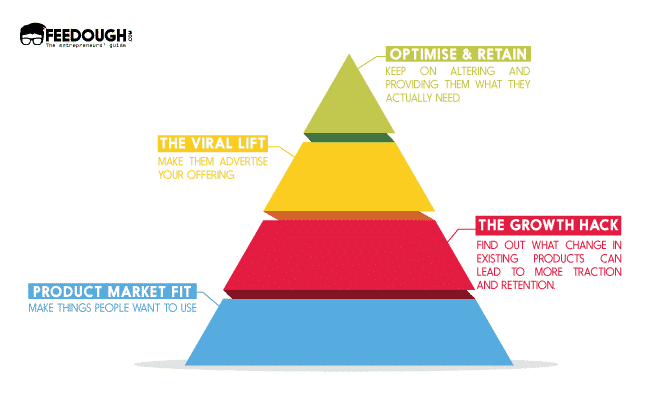Grow, grow, and grow! This is the obsession of most companies, especially those that are just initiating their operations. So, how to leverage this expansion? The answer is on growth hacking.
A term that has become popular in recent years, growth hacking, proves to be a powerful solution for making businesses grow.
It is a new way of thinking about Digital Marketing, which leads companies to their goals faster, using as few resources as possible.
In this article, we’ll show you that growth hacking is much more than a buzzword. You will learn about:
- What is Growth Hacking
- What a growth hacker does
- Why use growth hacking
- The 4 phases of growth hacking
- Key growth hacking strategies
- Successful cases of growth hacking
- Tools to grow your business
Do you want to learn all about growth hacking? Then, keep on reading!
Download this post by entering your email below
What is Growth Hacking
Growth hacking is a method used to enable strategies aiming at achieving significant and accelerated business growth by identifying its critical points.
These strategies include conducting experiments. The teams develop hypotheses, verify their validity, perform tests, and discover gaps or opportunities that make the business grow smarter and faster.
This is why growth hacking is defined as experiment-oriented marketing by Sean Ellis, the expert who coined the term and used this strategy to accelerate startups that became giants, such as Dropbox and Eventbrite.
The critical points of a company, that guide growth hacking, are identified by the KPIs that measure its success, such as traffic, leads, and sales.
If the critical point is traffic, for example, then growth hacking turns this KPI into experiments that can efficiently attract more visitors to the website.
The definition of KPIs depends on what each company understands by success. For example, for an online store, the main KPI is probably the number of sales (which can be broken down into other KPIs).
For a website that is monetized with ads, what matters most is traffic. So it would take some planning to define them.
But after reading this, you may wonder: what is the difference between growth hacking and other marketing techniques that also target growth?
First, realize that not every technique targets KPIs — many companies waste time and money on strategies that do not contribute to their goals. Growth hacking, on the other hand, always focuses on the objectives.
The big difference is the emphasis on accomplishing all this as quickly and inexpensively as possible with the experimentation method, which validates the hypotheses. Growth hacking attempts to discover doors to growth with less cost and more speed.
However, do not assume that hacks work like magic! You need to invest in tools that allow you to perform experiments and automation, and assemble teams to find the best solutions.
So, what do you need to practice growth hacking? We can summarize the fundamental parts of this process as follows:
- Objective: clearly define the goal of growth hacking.
- Hypothesis: develop hypotheses based on the know-how and intuition of your professionals.
- Experiments: conduct tests to prove the hypothesis’s efficiency.
- Tools: use testing, analytics, and automation tools.
Now, let us find out more about the professionals responsible for this area in a company.
What a growth hacker does
The word “hack” in the expression growth hacking might lead to confusion. Many people associate this type of strategy with the practice of computer hackers who look for security holes in our systems.
For this reason, there are quite a few people who think that growth hacking is unethical and illegal (although not every hacker is unethical and illegal, ok?). There is nothing like that, although this connection helps to explain what a growth hacker does.
In the same way that a computer hacker is famous for finding and exploring security holes, the growth hacker is the professional who finds “open gateways” to grow the results of a business rapidly.
Their goal is also to find breaches, but in a way that will provide intelligent and accelerated growth for the company. All within the limits of the law and ethics!
The association with hackers also implies that growth hacking is pure technology, programming, and mathematics. The practice usually involves these areas because they typically provide faster and more efficient solutions. But the concept is much more comprehensive and involves broader business strategies.
Therefore, the growth hacker does not need to be an IT or programming professional, although this knowledge would help in aligning with other programmers on the team.
Generally, the growth hacker is a marketing professional who is already focused on business growth. But those who enter this area should not think only about sales or revenue, but rather about the company’s goals and the efficiency — faster and cheaper — to achieve them.
Growth hackers are usually creative and exploratory, looking for growth possibilities and proposing new hypotheses. They are also agile and analytical, testing and proving their efficiency through data.
In addition to technical and conceptual marketing knowledge, a growth hacker needs to have a good understanding of:
- processes;
- experiment methodology;
- technology and development;
- data analysis;
- consumer behavior.
Knowing how people think along the buying journey, how they react, and what motivates them is essential for a growth hacker. Once they understand this, the professionals use their marketing knowledge to find possible growth triggers and methodically conduct experiments to prove their hypotheses.
If proven, they become repeatable and scalable, allowing the company to spend less time and money on that task.
To accomplish all this, many businesses not only hire or train growth hackers, but also set up growth teams.
The teams may consist of the following positions:
- Growth master, who is the team manager and makes the final decisions;
- Growth marketers (specialists in SEO, social media, email marketing etc.), who propose and implement experiments focused on KPIs;
- Growth analysts, who feed the team with performance data analysis concerning the experiments and the implemented strategies;
- Designers, programmers, and engineers, who develop products, tools, and software derived from the experiments.
With this combination of expertise, it is possible to cover all ends of the growth hacking process.
Although many companies have a growth hacker or growth hacking teams, usually within marketing, growth hacking is a way of thinking rather than a formal position.
Any professional can and should adopt this exploratory, creative, opportunity-seeking, and results-focused behavior.
Growth hacking is a reality in marketing, sales, accounting, and any other company area where there are potential triggers for growth.
Why use growth hacking
The old marketing formulas are facing a lot of changes. In the past, you would contact traditional media outlets (radio and TV, for example), analyze the advertising costs, assess the outlet’s affinity with your audience, negotiate prices, and air your ad.
But who could guarantee that your ad would reach the number of people you wanted? Or that you would get the expected return on your investment?
This is how companies bought advertising, without any guarantees — which could be very expensive, especially for brands with tight budgets.
The questions also began to come from the public. Traditional advertising has to work hard to convince people who no longer accept what brands say as the absolute truth. Instead, they take their criticisms to the Internet and can put the entire investment at risk.
Therefore, investing in traditional advertising has become unfeasible for many companies, both because of the cost and the public’s rejection. So brands looked for new ways to get results through marketing. And this is why growth hacking has gained so much buzz.
Growth hacking presents itself as a safer solution for companies, since it relies on experimentation and data analysis before applying strategies.
Such strategies are only adopted if the experiments prove their effectiveness, i.e., if they provide faster and cheaper solutions than traditional marketing.
The mission of growth hacking is to make businesses scalable, repeatable, and sustainable. Suppose you invest in strategies that have no guaranteed return, that are not turned into processes, that require too many manual actions, and demand too much time and resources. In that case, your company is not using growth hacking.
Growth hackers look at some business activity and ask themselves: how can this be done at scale, with repeatable processes, and in such a way that the company does not spend so much time and money? It is out of this questioning that they look for growth opportunities.
This description of growth hacking explains why startups widely adopt this strategy.
They can use the technique to grow their business rapidly and with few resources, proving to potential partners and investors their ability to generate market impact.
Thus, growth hacking helps startups to be scalable, have repeatable processes, and become sustainable.
Large companies can also use growth hacking to meet specific objectives, such as boosting growth or launching new products or services.
Growth hacking often serves to indicate whether a new product is sustainable, fast-growing and whether the company is on the right track before it starts investing heavily in advertising.
However, these types of companies usually do not have the internal structure that enables growth hacking results. So they need to change their organizational culture and get closer to the environment of startups — much more flexible, less hierarchical, and less bureaucratic.
Growth hacking demands a culture of experimentation that encourages risk and accepts error.
After all, this is what these professionals do: they assume a hypothesis that can go wrong, but that, if verified and successful, will leverage results.
This does not mean that the technique is a “shot in the dark” because experiments only become processes after being tested and validated.
Moreover, it is also vital that the team and the professionals are granted autonomy to make decisions. If it is necessary to go through the entire hierarchy to approve a tool, an experiment that could last only a week will take months to be executed. Thus, the whole process would lose agility and would not accomplish its purpose.
That is why growth hacking is generally more efficient in startups and small businesses, often in the technology or digital area.
The 4 phases of growth hacking
Growth hacking is all about process. There’s no point in starting experiments without a method and applying techniques without a purpose.
Therefore, we will now present the phases of this process so that you can reap faster and more cost-effective results through growth hacking.

1. Product-Market Fit
Create products that people want to use: this is the basis of marketing, startups, and, of course, growth hacking.
In this first step, you need to think about the alignment between product and market. Product-Market Fit refers to creating a product that is desired by the market and is able to satisfy its need.
This step often explains the failure of many products, which are placed in the wrong market or created without targeting the audience’s needs.
To fulfill this step, it is necessary to understand people, their needs and desires, their motivations, their buying journey etc. Then, it is possible to develop products that they want or need to use.
And we are not necessarily talking about creating a revolutionary product. Often, a slight change in what your company already sells or in the process you already use can serve to meet the market needs and bring excellent results.
One technique used to check whether your product is aligned with the market is the 40% Rule, created by Sean Ellis.
This technique checks, through a questionnaire, how your customers would feel if your product ceased to exist.
If more than 40% answer that they would be “very disappointed” (instead of “indifferent” or “not very disappointed”), then you have Product-Market Fit.
2. Growth Hacks
The second stage consists of applying growth hacks. This is where the team formulates hypotheses, experiments start to come to life, and the first users start to arrive. The intention is to identify which changes can generate the fastest and most cost-effective results.
To do this, the growth hackers must look at the product and, based on their know-how and intuition, find vulnerabilities and opportunities for growth.
This is how hypotheses are formulated: “what would happen if we did it differently? What if we added an element to the product? What if we used a certain tool in the process?”.
A good example was the strategy adopted by Quora, a website specializing in Q&As. They needed to boost user acquisition to support their platform with answers that people would trust.
So the company asked itself, “what if we invited well-known, influential, and authoritative professionals to the platform?”
And then, the company targeted its marketing efforts at this type of user. Thus, Quora boosted the platform’s user acquisition, turning it into a recognized source of information.
3. Scale and dissemination
Growth hacking is a growth strategy that seeks to use as few resources as possible.
Thus, the ideal way to approach it is by getting your own consumers to become your product’s propagators — and earn some benefit for that.
Perhaps this is the most difficult stage. Not every solution can go viral, but success will always depend on the power of word-of-mouth. What you can do is give it a “push” to make it happen.
A good example is Candy Crush, the famous puzzle game that went viral on Facebook. The game boosted user acquisition when it defined that users would gain more lives as they invited more people to play.
Thus, there was no need to invest in ads or traditional marketing — the users themselves would do the work.

Another example is Hotmail. In its early years, one detail in the email messages made all the difference.
The phrase “PS I Love You. Get Your Free E-mail at Hotmail” was placed in all messages’ footer and significantly increased the user base. In six months, there were more than a million registered users. In one year, 10 million.
Therefore, in this phase of the experiment, a business shows its potential for scalability. After running an experiment, getting the first users, and obtaining results, it is necessary to scale it.
With an expanded user base, you also begin to understand your audience better.
And when we talk about scaling, we are talking about automating actions. A scalable process cannot be manual.
4. Optimization and retention
Finally, you need to optimize the solution to improve usability and satisfy users. The goal now is to retain the consumers you have won to consolidate the customer base.
If this happens, the experiment is finished and approved. From there, it can become a process in the company.
Here, testing, feedback, and data analysis play an essential role. You should check the metrics — keeping an eye on the KPIs, which we explained earlier — to find out how customers are using your product, whether they are coming back to use it, and if not, what’s causing this.
Then, with such information, continuously optimize your solution to meet users’ needs.
Growth hacking is not about pitching an idea, approving it, and then calling it a day. The process involves continuous improvement and requires you to optimize the idea regularly to improve the user experience consistently.
Furthermore, a completed experiment unlocks doors for others. The team cannot stand still, as there is always a new problem waiting for new ideas and solutions.
Key growth hacking strategies
The application of growth hacking strategies depends on setting KPIs, which may vary from business to business. Therefore, each company must think of its particular KPIs.
But some strategies usually work for all types of companies with expressive results. Below, you can check the main approaches we recommend and reflect if they meet your company’s needs.
Referral marketing
Companies such as Paypal, Dropbox, and Uber consolidated themselves through this strategy. And this is one of the leading promoting strategies in the process of growth hacking.
Referral marketing consists of turning your customers into brand advocates. Generally, the system works like this: the user indicates a person to be a client and receives a reward for this (many times, the person indicated also earns benefits).
The Paypal case was a pioneer in this: in 1999, the online payment system gained 100,000 users in the first month of operation, simply by paying $20 per referral.
In this way, marketing encourages word-of-mouth dissemination, which is essential to reduce customer acquisition costs, leverage the user base, and boost the company’s growth.
Referral marketing is also related to loyalty marketing. After all, loyal customers tend to recommend your product or service to people they know. So, you can also combine this strategy with loyalty programs.
Content Marketing
Content Marketing is one of the top strategies when it comes to traffic growth. If you have a blog containing relevant posts about your area of expertise, you will undoubtedly receive more visitors in an organic and scalable way. However, blogging alone is not enough for rapid and significant growth.
If you want to accelerate your blog’s traffic acquisition, it is essential to adopt other Content Marketing strategies.
First, you should optimize your publications with SEO. By applying on-page SEO techniques and getting backlinks to your pages, your blog grows faster. Start these optimizations with posts that are already successful and tend to experience exponential growth.
Adopting a strategy of guest posts on partner blogs is also a way to increase your blog’s audience more robustly, rather than just waiting for visitors to arrive spontaneously.
Whereas if your goal is to increase lead acquisition with Content Marketing, you need to use captivating elements on your blog pages.
Inserting pop-ups, forms, banners, and CTAs on the pages is a way to encourage the user to share their email information and grow your contact base. Also, do this in the publications that already perform better in order to accelerate growth.
Scarcity Principle
This is one of the primary mental triggers used in growth hacking because it can motivate people to buy the product right away. This principle is based on the idea that everything that is scarce is more valuable.
When a consumer realizes that a product is running out or is restricted to only a few people (or is led to believe this!), they want to secure theirs immediately.
You can also use this scarcity principle by advertising limited editions of your product or time-limited discounts. Test and verify the impact of these actions on your results.
Constant testing
Experimentation culture demands the execution of constant tests. The most popular are A/B Tests, which consist of running two versions of a material (a landing page or an email marketing message, for example), with only one different variable between them. The goal is to verify which one generates more results.
To do this, it is essential to define which variable you want to evaluate and what result you want to obtain. For example, you may find that a specific email title generates more views but fewer conversions.
If your goal is to convert, then this test has shown that the title does not work for what you want. As we said, growth hacking always targets the goals.
But there is more than just A/B testing. You can apply any kind of experiment in growth hacking. The only requirement is that they must be based on data to support the decisions.
For example, you can run a software version for a select group of customers, see what results it generates, and then decide whether or not to include it in the process.
Successful cases of growth hacking
Facebook has recently reached the mark of 2.3 billion active users, and much of this success is due to the growth hacking mentality that the company has displayed since day one.
When the platform became accessible to everyone, not just college students, acquiring new users became a significant challenge: how to remain interesting if now anyone could be invited?
Facebook’s first hack was to allow people to add badges and widgets to their websites (the evolution of these widgets is the current Page Plugin). By doing this, people accessing the site were invited to like that site’s Facebook page — and ended up creating a profile.
Another growth hack by Facebook was related to user retention.
By analyzing the behavior of users who remained active on the social network, Facebook’s growth hackers came up with an activation metric:
“Those who add 7 friends in the first 10 days have a much higher chance of staying an active user.”
With that in mind, they created several features to encourage new profiles to find those first 7 friends.
One of them happens when you are encouraged to associate your email account while creating your profile. With that, Facebook searches your contacts to suggest friends for you.
A friend of yours can also suggest people that you have not yet added. This feature shows up a lot for friends of a person who has just created their account. After a while, it becomes less common.
One of LinkedIn’s most famous growth hacking actions helped the company grow from 2 million to 200 million active users.
The change implemented for this was the possibility to create public profiles, visible to people who were not on LinkedIn.
Sounds contradictory, doesn’t it? If it is possible to view a profile without creating an account, why would I create an account?
The key was that LinkedIn fully optimized these profiles for SEO. When someone Googled someone else’s name, one of the first results that came up was their LinkedIn profile.
The same thing happened to people who searched for company names: there it was, ranked in Google.
This was a significant growth trigger.
Obviously, it was not a random attempt. Remember that the growth hacker needs to have a good knowledge of people and their behaviors?
LinkedIn professionals have likely noticed that people tend to Google their new professional contacts and look for the companies where they work.
Realizing this, LinkedIn took the opportunity to position itself as an authority on these search results — after all, viewing a person’s resume is quite relevant when you want to know more about them!
Quora
Quora is a website that specializes in questions and answers. You can create your profile, ask a question, and expect people around the world to answer it according to their knowledge.
One of Quora’s biggest challenges was user acquisition. How could people trust that they would find quality answers on the site?
To do this, the company targeted its efforts at acquiring well-known and trusted users.
When people realized that they could ask a question about technology and startups, for example, and get answers from influential people in the field — founders, marketing directors, etc. — the public started to see Quora as an excellent source of knowledge.
Details: the two founders of Quora are former Facebook employees. In other words, the company was born with a strong culture of growth hacking.
Tools to grow your business
There are no specific tools for growth hacking. In this process, you will adopt tools that you may have used in traditional marketing.
The difference is the mindset you will apply when using them.
And the tools you will use depend on the experiments you will perform. Perhaps you focus on SEO and need to use keyword and competition analysis tools, such as Google Search Console, Keyword Explorer, and SEMrush.
If you focus on the social media arena, management and automation tools, such as mLabs and Hootsuite, may be helpful. For email marketing, triggering tools such as MailChimp or GetResponse.
Everything will depend on the type of experiment you are going to conduct. However, some tools are unavoidable: you will need testing and data analysis tools intrinsic to growth hacking.
For testing, Google offers a handy tool: Google Optimize. It allows you to optimize any HTML element on a page, such as blog posts, CTAs, landing pages, images, and forms.
Another interesting tool is Optimizely, which allows you to run more advanced experiments on websites, mobile apps, TV apps, and Internet of Things.
Besides, many email marketing, social media, and automation tools, for example, include A/B Testing in their native features.
Some examples of tools with this feature are:
- RD Station (automation);
- LeadLovers (automation);
- MailChimp (email marketing);
- GetResponse (email marketing);
- Unbounce (landing pages);
- LeadPages (landing pages).
For data analysis, you have some great free tools. Let’s see now a list of the must-haves:
- Google Analytics, the leading free digital analytics tool;
- Hotjar, to analyze the user experience on a website and gather feedback in real-time;
- SimilarWeb, for website and competitor analysis;
- Facebook Analytics, Instagram Insights, Twitter Analytics, which are the native social media data analysis tools.
You might think that some of these tools are too expensive and undermine the idea of getting cheaper results with growth hacking.
In that case, you need to evaluate your company’s budget and the expected return to find out what is worth your time and money. But it will undoubtedly be cheaper than placing an advertisement on TV.
Now you know how growth hacking works. Remember that it is not a magic trick. A growth hacker is a curious, creative, and analytical professional who wants to find opportunities that no one has noticed before to accelerate companies’ growth.
Unlike traditional marketing, growth hacking is concerned with achieving KPIs as quickly and cost-effectively as possible, using breaches and gaps. As we said, this is the obsession of a growth hacker!
They use experiments to validate ideas that are scalable, repeatable, and sustainable for the business. If it does not meet these requirements, it is not compatible with growth hacking.
Now, start adopting this growth mindset in your company. To help you, we provide a free bundle with everything you need to plan your marketing strategies for this year!









